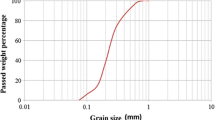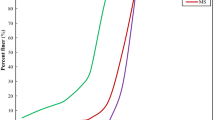Abstract
It is widely known and well emphasized that the cemented sand is one of economic and environmental topics in soil stabilization. In some instances, a blend of sand, cement and other materials such as fiber, glass, nano particle and zeolite can commercially be available and effectively used in soil stabilization especially in road construction. In regard to zeolite, its influence and effectiveness on the properties of cemented sands systems has not been completely explored. Hence, in this study, based on an experimental program, it has been tried to investigate the potential of a zeolite stabilizer known as additive material to improve the properties of cemented sands. A total number of 216 unconfined compression tests were carried out on cured samples in 7, 28 and 90 days. Results show unconfined compression strength and failure properties improvements of cement sand specimens when cement replaced by zeolite at optimum proportions of 30 % after 28 days due to pozzolanic reaction. The rate of strength improvement is approximately 20–78 and 20–60 % for 28 and 90 days curing times respectively. The efficiency of using zeolite has been enhanced by increasing the cement content and porosity of the compacted mixture. The replacement of cement by natural zeolite led to an increase of the pH after 14 days. Chemical oxygen demand (COD) tests demonstrate that the materials with the zeolite mixture reveal stronger adsorptive capacity of COD in compare to cemented mixture. Scanning electron microscope images show that adding zeolite in cemented sand changes the microstructure (filling large porosity and pozzolanic reaction) that results in increasing strength.










Similar content being viewed by others
References
Arabani M, Sharafi H, Habibi MR, Haghshenas E (2015) Laboratory evaluation of cement stabilized crushed glass-sand blends. Electron J Geotech Eng 17:1777–1792
ASTM C 150 (2007) Standard specification for Portland cement. American Society for Testing and Materials, Philadelphia
ASTM D 2166 (2000) Standard test method for unconfined compressive strength of cohesive soil. American Society for Testing and Materials, Philadelphia
Bhatmagar A, Minocha AK (2006) Conventional and non-conventional adsorbents for removal of pollutants from water-a review. Indian J Chem Tech 13(3):203–217
Canpolat F, Yılmaz K, Kose MM, Sumer M, Yurdusev MA (2004) Use of zeolite, coal bottom ash and fly ash as replacement materials in cement production. Cem Concr Res 34(5):731–735
Choobbasti AJ, Vafaei A, Kutanaei SS (2015) Mechanical properties of sandy soil improved with cement and nanosilica. Open Eng 5(1):111–116
Clough GW, Sitar N, Bachus RC, Rad NS (1981) Cemented sands under static loading. J Geotech Eng Div 107(6):799–817
Consoli NC, Foppa D (2014) Porosity/cement ratio controlling initial bulk modulus and incremental yield stress of an artificially cemented soil cured under stress. Géotech Lett 4:22–26
Consoli NC, Prietto PDM, Ulbrich LA (1998) Influence of fiber and cement addition on behavior of sandy soil. J Geotech Geoenviron 124(12):1211–1214
Consoli NC, Rotta GV, Prietto PDM (2000) The influence of curing under stress on the triaxial response of cemented soils. Géotechnique 50(1):99–105
Consoli NC, Rotta GV, Prietto PDM (2006) Yielding-compressibility–strength relationship for an artificially cemented soil cured under stress. Géotechnique 56(1):69–72
Consoli NC, Foppa D, Festugato L, Heineck KS (2007) Key parameters for strength control of artificially cemented soils. J Geotech Geoenviron 133(2):197–205
Consoli NC, Lopes LS Jr, Foppa D, Heineck KS (2009) Key parameters dictating strength of lime/cement-treated soil. Proc Inst Civ Eng Geotech Eng 162(2):111–118
Consoli NC, Festugato L, da Rocha CG, Cruz RC (2013a) Key parameters for strength control of rammed sand–cement mixtures: influence of types of Portland cement. Constr Build Mater 49:591–597
Consoli NC, Consoli BS, Festugato L (2013b) A practical methodology for the determination of failure envelopes of fiber-reinforced cemented sands. Geotext Geomembr 41:50–54
Coop MR, Atkinson JH (1993) The mechanics of cemented carbonate sands. Geotechnique 43(1):53–67
Dalla Rosa F, Consoli NC, Baudet BA (2008) An experimental investigation of the behaviour of artificially cemented soil cured under stress. Geotechnique 58(8):675–679
Feng NQ, Li GZ, Zang XW (1990) High strength and flowing concrete with a zeolite mineral admixture. Cem Concr Aggreg ASTM 12:61–69
Horpibulsuk S, Suddeepong A, Suksiripattanapong C, Chinkulkijniwat A, Arulrajah A, Disfani MM (2014) Water-void to cement ratio identity of lightweight cellular-cemented material. J Mater Civ Eng 26(10):06014021
Huang JT, Airey D (1998) Properties of artificially cemented carbonate sand. J Geotech Geoenviron 124(6):492–499
Ladd RS (1978) Preparing test specimens using under compaction. Geotech Test J 1(1):16–23
Napia C, Sinsiri T, Jaturapitakkul C, Chindaprasirt P (2012) Leaching of heavy metals from solidified waste using Portland cement and zeolite as a binder. Waste Manag 32(7):1459–1467
Perraki T, Kakali G, Kontoleon F (2003) The effect of natural zeolites on the early hydration of Portland cement. Micropor Mesopor Mat 61(1):205–212
Pino LFM, Baudet BA (2015) The effect of the particle size distribution on the mechanics of fibre-reinforced sands under one-dimensional compression. Geotext Geomembr 43(3):250–258
Poon CS, Lam L, Kou SC, Lin ZS (1999) A study on the hydration rate of natural zeolite blended cement pastes. Constr Build Mater 13(8):427–432
Shi JX (2012) The applications of zeolite in sustainable binders for soil stabilization. Appl Mec Mater 256:112–115
Shi C, Day RL (2000) Pozzolanic reaction in the presence of chemical activators: Part II—reaction products and mechanis. Cem Concr Res 30(4):607–613
Thomé A, Donato M, Consoli NC, Graham J (2005) Circular footings on a cemented layer above weak foundation soil. Can Geotec J 42(6):1569–1584
Yilmaz E, Belem T, Benzaazoua M (2015) Specimen size effect on strength behavior of cemented paste backfills subjected to different placement conditions. Eng Geol 185:52–62
Yılmaz B, Ucar A, Oteyaka B, Uz V (2007) Properties of zeolitic tuff (clinoptilolite) blended portland cement. Build Environ 42(11):3808–3815
Author information
Authors and Affiliations
Corresponding author
Rights and permissions
About this article
Cite this article
Mola-Abasi, H., Kordtabar, B. & Kordnaeij, A. Effect of Natural Zeolite and Cement Additive on the Strength of Sand. Geotech Geol Eng 34, 1539–1551 (2016). https://doi.org/10.1007/s10706-016-0060-4
Received:
Accepted:
Published:
Issue Date:
DOI: https://doi.org/10.1007/s10706-016-0060-4




